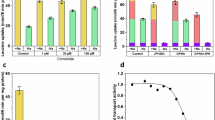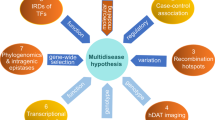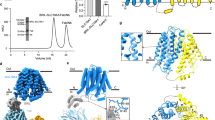Abstract
Hartnup disorder, an autosomal recessive defect named after an English family described in 1956 (ref. 1), results from impaired transport of neutral amino acids across epithelial cells in renal proximal tubules and intestinal mucosa. Symptoms include transient manifestations of pellagra (rashes), cerebellar ataxia and psychosis1,2. Using homozygosity mapping in the original family in whom Hartnup disorder was discovered, we confirmed that the critical region for one causative gene was located on chromosome 5p15 (ref. 3). This region is homologous to the area of mouse chromosome 13 that encodes the sodium-dependent amino acid transporter B0AT1 (ref. 4). We isolated the human homolog of B0AT1, called SLC6A19, and determined its size and molecular organization. We then identified mutations in SLC6A19 in members of the original family in whom Hartnup disorder was discovered and of three Japanese families. The protein product of SLC6A19, the Hartnup transporter, is expressed primarily in intestine and renal proximal tubule and functions as a neutral amino acid transporter.
This is a preview of subscription content, access via your institution
Access options
Subscribe to this journal
Receive 12 print issues and online access
$259.00 per year
only $21.58 per issue
Buy this article
- Purchase on SpringerLink
- Instant access to full article PDF
Prices may be subject to local taxes which are calculated during checkout



Similar content being viewed by others
References
Baron, D.N., Dent, C.E., Harris, H., Hart, E.W. & Jepson, J.B. Hereditary pellagra-like skin rash with temporary cerebellar ataxia, constant renal amino-aciduria, and other bizarre biochemical features. Lancet 271, 421–428 (1956).
Levy, H.L. Hartnup disorder. in The Metabolic and Molecular Bases of Inherited Disease 8th edn., vol. III (eds. Scriver, C.R., Beaudet, A.L., Valle, D.L. & Sly, W.S.) 4957–4969 (McGraw-Hill, New York, 2001).
Nozaki, J. et al. Homozygosity mapping to chromosome 5p15 of a gene responsible for Hartnup disorder. Biochem. Biophys. Res. Commun. 284, 255–260 (2001).
Broer, A. et al. Molecular cloning of mouse amino acid transport system B0, a neutral amino acid transporter related to Hartnup disorder. J. Biol. Chem. 279, 24467–24476 (2004).
Bernardini, I., Introne, W., Kleta, R., Fitzpatrick, D.L. & Gahl, W.A. Detection of Hartnup's disorder in an alkaptonuria sibship. Am. J. Hum. Genet. 69, Suppl. 1, 1784 (2001).
Virlon, B. et al. Serial microanalysis of renal transcriptomes. Proc. Natl. Acad. Sci. USA 96, 15286–15291 (1999).
Shih, V.E., Bixby, E.M., Alpers, D.H., Bartsocas, C.S. & Thier, S.O. Studies of intestinal transport defect in Hartnup disease. Gastroenterology 61, 445–453 (1971).
Verrey, F. et al. CATs and HATs: the SLC7 family of amino acid transporters. Pflugers Arch. 447, 532–542 (2004).
Palacin, M., Goodyer, P., Nunes, V., Gasparini & Cystinuria, P. in The Metabolic and Molecular Bases of Inherited Disease 8th edn., vol. III (eds. Scriver, C.R., Beaudet, A.L., Valle, D.L. & Sly, W.S.) 4909–4932 (McGraw-Hill, New York, 2001).
Kleta, R., Stuart, C., Gill, F.A. & Gahl, W.A. Renal glucosuria due to SGLT2 mutations. Mol. Genet. Metab. 82, 56–58 (2004).
Seow, H.F. et al. Hartnup disorder is caused by mutations in SLC6A19, encoding the neutral amino acid transporter. Nat. Genet. advance online publication, 1 August 2004 (doi:10.1038/ng′).
Lander, E.S. & Botstein, D. Homozygosity mapping: a way to map human recessive traits with the DNA of inbred children. Science 236, 1567–1570 (1987).
Kruglyak, L., Daly, M.J. & Lander, E.S. Rapid multipoint linkage analysis of recessive traits in nuclear families, including homozygosity mapping. Am. J. Hum. Genet. 56, 519–527 (1995).
Cottingham, R.W. Jr., Idury, R.M. & Schaffer, A.A. Faster sequential genetic linkage computations. Am. J. Hum. Genet. 53, 252–263 (1993).
Schafer, J.A. et al. A simplified method for isolation of large numbers of defined nephron segments. Am. J. Physiol. 273, F650–F657 (1997).
Levy, D.I., Velazques, H., Goldstein, S.A. & Bockenhauer, D. Segment-specific expression of 2P domain potassium channel genes in human nephron. Kidney Int. 65, 918–926 (2004).
Kanai, Y. & Hediger, M.A. Primary structure and functional characterization of a high-affinity glutamate transporter. Nature 360, 467–471 (1992).
Acknowledgements
We thank D. Bacic for help with frozen sections, L.G. Palacio for statistical analyses, F. Skovby for expert advice and the families who graciously participated in this study. This study was supported by Grants-in-aid from the Japanese Government to A.K. and by Swiss National Science Foundation grants to F.V.
Author information
Authors and Affiliations
Corresponding author
Ethics declarations
Competing interests
The authors declare no competing financial interests.
Rights and permissions
About this article
Cite this article
Kleta, R., Romeo, E., Ristic, Z. et al. Mutations in SLC6A19, encoding B0AT1, cause Hartnup disorder. Nat Genet 36, 999–1002 (2004). https://doi.org/10.1038/ng1405
Received:
Accepted:
Published:
Issue date:
DOI: https://doi.org/10.1038/ng1405
This article is cited by
-
Structural insight into the substrate recognition and transport mechanism of amino acid transporter complex ACE2-B0AT1 and ACE2-SIT1
Cell Discovery (2023)
-
Urine metabolomics links dysregulation of the tryptophan-kynurenine pathway to inflammation and severity of COVID-19
Scientific Reports (2022)
-
The Lepidopteran KAAT1 and CAATCH1: Orthologs to Understand Structure–Function Relationships in Mammalian SLC6 Transporters
Neurochemical Research (2022)
-
COVID-19 and Hartnup disease: an affair of intestinal amino acid malabsorption
Eating and Weight Disorders - Studies on Anorexia, Bulimia and Obesity (2021)



